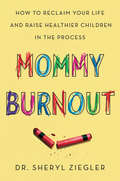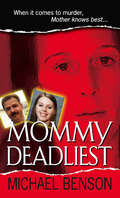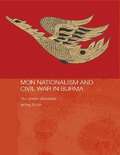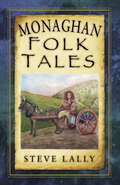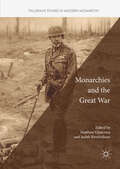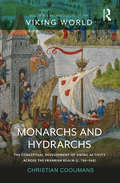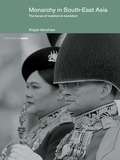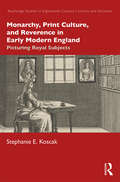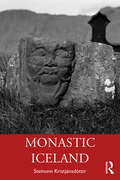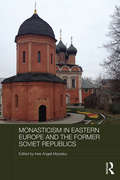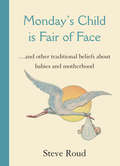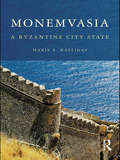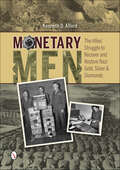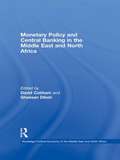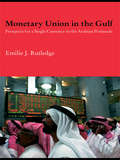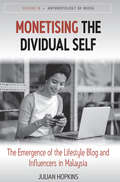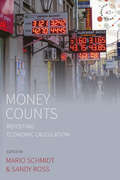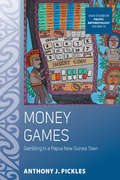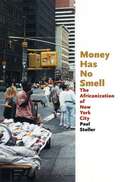- Table View
- List View
Mommy Burnout: How to Reclaim Your Life and Raise Healthier Children in the Process
by Dr Sheryl G. ZieglerThe ultimate must-read handbook for the modern mother: a practical, and positive tool to help free women from the debilitating notion of being the "perfect mom," filled with funny and all too relatable true-life stories and realistic suggestions to stop the burnout cycle, and protect our kids from the damage burnout can cause.Moms, do you feel tired? Overwhelmed? Have you continually put off the things you need to do for you? Do you feel like it’s all worth it because your kids are happy? Are you "over" being a mother? If you answered yes to these questions, you’re not alone. Parents today want to create the ideal childhood for their children. Women strive to be the picture-perfect Pinterest mother that looks amazing, hosts the best birthday parties in town, posts the most "liked" photos, and serves delicious, nutritious home-cooked meals in her neat, organized home after ferrying the kids to school and a host of extracurricular activities on time.This drive, while noble, can also be destructive, causing stress and anxiety that leads to "mommy burnout." Psychologist and family counselor Dr. Sheryl Ziegler is well-versed in the stress that moms face, and the burden of guilt they carry because they often feel like they aren’t doing enough for their kids’ happiness. A mother of three herself, Dr. Z—as she’s affectionately known by her many patients—recognizes and understands that modern moms are all too often plagued by exhaustion, failure, isolation, self-doubt, and a general lack of self-love, and their families are also feeling the effects, too.Over the last nineteen years working with families and children, Dr. Z has devised a prescriptive program for addressing "mommy burnout"—teaching moms that they can learn to re-energize themselves and still feel good about their families and their lives. In this warm and empathetic guide, she examines this modern epidemic among mothers who put their children’s happiness above their own, and offers empowering, proven solutions for alleviating this condition, saving marriages and keeping kids happy in the process.
Mommy Deadliest
by Michael BensonCASE FEATURED ON 20/20ANTI-FREEZE FOR A HUSBANDIt looked like a suicide. A man's corpse on the bathroom floor—next to a half-empty glass of anti-freeze. But fingerprints on the glass belonged to the deceased's wife, Stacey Castor. And a turkey baster in the garbage had police wondering if she force-fed the toxic fluid down her husband's throat. PILLS FOR A DAUGHTERIn desperation, Stacey concocted a devious plan. She mixed a deadly cocktail of vodka and pills, then served it to her twenty-year-old daughter Ashley. The authorities would find Ashley with a suicide note, confessing to the anti-freeze murder. But Stacey's plan backfired—because Ashley refused to die . . . A KILLER FOR A MOTHERCharged with murdering her second husband—and attempting to kill her oldest daughter—Stacey Castor sparked a media frenzy. But when police dug up her first husband's grave—and found anti-freeze in his body, too—this New York housewife earned a nickname that would follow her all the way to prison. They called her 'The Black Widow. ' And with good reason. Includes 16 Pages of Shocking Photos
Mommy Wars: Stay-at-Home and Career Moms Face Off on Their Choices, Their Lives, Their Families
by Leslie Morgan SteinerWith motherhood comes one of the toughest decisions of a woman’s life: Stay at home or pursue a career? The dilemma not only divides mothers into hostile, defensive camps but pits individual mothers against themselves. Leslie Morgan Steiner has been there. As an executive at The Washington Post, a writer, and mother of three, she has lived and breathed every side of the “mommy wars.” Rather than just watch the battles rage, Steiner decided to do something about it. She commissioned twenty-six outspoken mothers to write about their lives, their families, and the choices that have worked for them. The result is a frank, surprising, and utterly refreshing look at American motherhood. Ranging in age from twenty-five to seventy-two and scattered across the country from New Hampshire to California, these mothers reflect the full spectrum of lifestyle choices. Women who have been home with the kids from day one, moms who shuttle from full-time office jobs to part-time at-home work, hard-driving executives who put in seventy-hour-plus weeks: they all get a turn. The one thing these women have in common, aside from having kids, is that they’re all terrific writers. Pulitzer Prize winner Jane Smiley vividly recounts how her generation stormed the American workplace–only to take refuge at home when the workplace drove them out. Lizzie McGuire creator Terri Minsky describes what it felt like to hear her kids scream “I hope you never come back!” when she flew to L.A. to launch the show that made her career. Susan Cheever, novelist, biographer, and New York Newsday columnist, reports on the furious battles between the stroller pushers and the briefcase bearers on the streets of Manhattan. Lois R. Shea traded the journalistic fast track for a house in the country where she could raise her daughter in peace. Ann Misiaszek Sarnoff, chief operating officer of the Women’s National Basketball Association, argues fiercely that you can combine ambition and motherhood–and have a blast in the process. Candid, engaging, by turns unflinchingly honest and painfully funny, the essays collected here offer an astonishingly intimate portrait of the state of motherhood today. Mommy Wars is a book by and for and about the real experts on motherhood and hard work: the women at home, in the office, on the job every day of their lives.
Mommyblogs and the Changing Face of Motherhood
by May FriedmanMothers have consistently relied upon one another for guidance and support as they navigate the difficult world of parenting. For many women, the increasingly established online community of "mommyblogs" now provides a source of camaraderie and support that acknowledges both the work of mothering and the implications of its undertaking. Beyond their capacity to entertain, how have mommyblogs shifted our understanding of twenty-first-century motherhood?In examining the content of hundreds of mommyblogs, May Friedman considers the ways that online maternal life writing provides a front row seat to some of the most raw, offbeat, and engaging portraits of motherhood imaginable. Focusing on the composition of the "mamasphere" and on mommyblogs' emphasis on connection, Friedman reveals the changing face of contemporary motherhood - one less concerned with the proscriptions of what good mothers should do, and more invested in what diverse mothers have to say.
Mon Nationalism and Civil War in Burma: The Golden Sheldrake
by Mr Ashley SouthA major contribution to the literature of Burmese history and politics, this book traces the rich and tragic history of the Mon people of Burma and Thailand, from the pre-colonial era to the present day. This vivid account of ethnic politics and civil war situates the story of Mon nationalism within the 'big picture' of developments in Burma, Thailand and the region. Primarily an empirical study, it also addresses issues of identity and anticipates Burmese politics in the new millennium. A particular feature of the book is its first-hand descriptions of insurgency and displacement, drawn from the author's experiences as an aid worker in the war zone.
Monacan Millennium: A Collaborative Archaeology and History of a Virginia Indian People
by Jeffrey L. HantmanWhile Jamestown and colonial settlements dominate narratives of Virginia’s earliest days, the land’s oldest history belongs to its native people. Monacan Millennium tells the story of the Monacan Indian people of Virginia, stretching from 1000 A.D. through the moment of colonial contact in 1607 and into the present.Written from an anthropological perspective and informed by ethnohistory, archaeology, and indigenous tribal perspectives, this comprehensive study reframes the Chesapeake’s early colonial period—and its deep precolonial history—by viewing it through a Monacan lens. Shifting focus to the Monacans, Hantman reveals a group whose ritual practices bespeak centuries of politically and culturally dynamic history. This insightful volume draws on archeology, English colonial archives, Spanish sources, and early cartography to put the Monacans back on the map. By examining representations of the tribe in colonial, postcolonial, and contemporary texts, the author fosters a dynamic, unfolding understanding of who the Monacan people were and are.
Monaghan Folk Tales
by Steve LallyWelcome to County Monaghan, a place full of ancient secrets, uncanny stories and unforgettable characters. Visit the majestic Castle Leslie with its haunted rooms and fairy folk, hear the piercing cry of the lonesome banshee at Rossmore Castle. Stop off to share a tune with the Bragan Ghost before joining the diabolical Skelton at his eerie inn. And don’t forget to avoid the gaze of the Graveyard Bride as you pass through Errigal Truagh Cemetery. Join author and professional storyteller Steve Lally as he brings together stories from one of Ireland’s most magical places. Accompanied by original, often haunting illustrations, these enchanting folk tales are sure to be enjoyed and shared time and again.
Monarchies and the Great War (Palgrave Studies in Modern Monarchy)
by Matthew Glencross Judith RowbothamThis volume challenges the traditional view that the First World War represents a pivotal turning point in the long history of monarchy, suggesting the picture is significantly more complex. Using a comparative approach, it explores the diverse roles played by monarchs during the Great War, and how these met the expectations of the monarchic institution in different states at a time of such crisis. Its contributors not only explore less familiar narratives, including the experiences of monarchs in Belgium and Italy, as well as the Austro-Hungarian, Japanese and Ottoman Empires, but also cast fresh light on more familiar accounts. In doing so, this book moves away from the conventional view that monarchy showed itself irrelevant in the Great War, by drawing on new approaches to diplomatic and international history - ones informed by cultural contextualization for instance - while grounding the research behind each chapter in a wide range of contemporary sources The chapters provide an innovative revisiting of the actual role of monarchy at this crucial period in European (indeed, global) history, and are framed by a substantial introductory chapter where the key factors explaining the survival or collapse of dynasties, and of the individuals occupying these thrones, are considered in a wide-ranging set of reflections that highlight the extent of common experiences as well as the differences.
Monarchs and Hydrarchs: The Conceptual Development of Viking Activity across the Frankish Realm (c. 750–940) (Routledge Archaeologies of the Viking World)
by Christian CooijmansAs the politico-economic exploits of vikings in and around the Frankish realm remain, to a considerable extent, obscured by the constraints of a fragmentary and biased corpus of (near-)contemporary evidence, this volume approaches the available interdisciplinary data on a cumulative and conceptual level, allowing overall spatiotemporal patterns of viking activity to be detected and defined – and thereby challenging the notion that these movements were capricious, haphazard, and gratuitous in character. Set against a backdrop of continuous commerce and knowledge exchange, this overarching survey demonstrates the existence of a relatively uniform, sequential framework of wealth extraction, encampment, and political engagement, within which Scandinavian fleets operated as adaptable, ambulant polities – or ‘hydrarchies’. By delineating and visualising this framework, a four-phased conceptual development model of hydrarchic conduct and consequence is established, whose validity is substantiated by its application to a number of distinct regional case studies. The parameters of this abstract model affirm that Scandinavian movements across Francia were the result of prudent and expedient decision-making processes, contingent on exchanged intelligence, cumulative experience, and the ongoing individual and collective need for socioeconomic subsistence and enrichment. Monarchs and Hydrarchs will appeal to both students and specialists of the Viking Age, whilst serving as an equally valuable resource to those investigating early medieval Francia, Scandinavia, and the North Sea world as a whole.
Monarchy in South East Asia: The Faces of Tradition in Transition (Politics in Asia)
by Roger KershawThis title is the first study to relate the history and contemporary role of the South East Asian monarchy to the politics of the region today. Comprehensive & up-to-date, Monarchy in South East Asia features an historical and political overview of *Cambodia *Thailand *Malaysia *Brunei *Indonesia *Laos *as well as the region in general. The excellent coverage of this fascinating subject should be of interest to general reader as well as to specialists focusing on region.
Monarchy, Print Culture, and Reverence in Early Modern England: Picturing Royal Subjects (Routledge Studies in Eighteenth-Century Cultures and Societies)
by Stephanie E. KoscakThis richly illustrated and interdisciplinary study examines the commercial mediation of royalism through print and visual culture from the second half of the seventeenth century. The rapidly growing marketplace of books, periodicals, pictures, and material objects brought the spectacle of monarchy to a wide audience, saturating spaces of daily life in later Stuart and early Hanoverian England. Images of the royal family, including portrait engravings, graphic satires, illustrations, medals and miniatures, urban signs, playing cards, and coronation ceramics were fundamental components of the political landscape and the emergent public sphere. Koscak considers the affective subjectivities made possible by loyalist commodities; how texts and images responded to anxieties about representation at moments of political uncertainty; and how individuals decorated, displayed, and interacted with pictures of rulers. Despite the fractious nature of party politics and the appropriation of royal representations for partisan and commercial ends, print media, images, and objects materialized emotional bonds between sovereigns and subjects as the basis of allegiance and obedience. They were read and re-read, collected and exchanged, kept in pockets and pasted to walls, and looked upon as repositories of personal memory, national history, and political reverence.
Monastic Iceland
by Steinunn KristjánsdóttirThis book provides an overview of medieval monasticism in Iceland, from its dawn to its downfall during the Reformation. Blending the evidence from material remains and written documents, Monastic Iceland highlights the realities of everyday life in the male and female monasteries operated in Iceland. The book describes the incorporation of monasticism into the Icelandic society, the alleged land of the Vikings, and thus how the monasteries coexisted with the natural and social environments on the island while keeping their general aims and objectives. The book shows that large social systems, such as monasticism, can cross social and natural borders without necessitating fundamental changes apart from those triggered by the constant coexistence of nature and culture inside the environment they exist within. The evidence provided debunks the myth that Icelandic monasteries, male or female, were isolated, silent places or simple cells functioning principally as retirement homes for aristocrats. To be a member of an ecclesiastical institution did not mean a quiet, secluded life without any outside interaction, but rather active participation in the surrounding community. The book is for researchers in archaeology, osteology, and medieval history, in addition to all those interested in monasticism and the medieval history of northern Europe.
Monastic Women and Religious Orders in Late Medieval Bologna
by Sherri Franks JohnsonSherri Franks Johnson explores the roles of religious women in the changing ecclesiastical and civic structure of late medieval Bologna, demonstrating how convents negotiated a place in their urban context and in the church at large. During this period Bologna was the most important city in the Papal States after Rome. Using archival records from nunneries in the city, Johnson argues that communities of religious women varied in the extent to which they sought official recognition from the male authorities of religious orders. While some nunneries felt that it was important to their religious life to gain recognition from monks and friars, others were content to remain local and autonomous. In a period often described as an era of decline and the marginalization of religious women, Johnson shows instead that they saw themselves as active participants in their religious orders, in the wider church and in their local communities.
Monasticism in Eastern Europe and the Former Soviet Republics (Routledge Religion, Society and Government in Eastern Europe and the Former Soviet States)
by Ines Angeli MurzakuThis book looks at Eastern and Western monasticism’s continuous and intensive interactions with society in Eastern Europe, Russia and the Former Soviet Republics. It discusses the role monastics played in fostering national identities, as well as the potentiality of monasteries and religious orders to be vehicles of ecumenism and inter-religious dialogue within and beyond national boundaries. Using a country-specific analysis, the book highlights the monastic tradition and monastic establishments. It addresses gaps in the academic study of religion in Eastern European and Russian historiography and looks at the role of monasticism as a cultural and national identity forming determinant in the region.
Monday's Child is Fair of Face: and Other Traditional Beliefs about Babies and Motherhood
by Steve RoudPregnancy and childbirth remains a mystical and magical time, characterised by feelings of hope, uncertainty and worry. No matter how many scientific innovations come along, there's still room for home-grown beliefs and traditions handed down through the family. Couples buying a pram may still ask for it to be delivered after the birth, and some grandparents will shrink from tickling the baby's feet in case it grows up to have a stammer. Monday's Child is Fair of Face gathers together these beliefs and customs, explaining how and why they arose, in which parts of the country they have been particularly popular, and to what extent they survive today. Arranged thematically, it's the perfect book to dip into, and its mixture of familiar, unfamiliar and frankly bizarre beliefs makes for compelling reading.
Monemvasia: A Byzantine City State
by Haris A. KalligasThis lavishly illustrated book stands out in its field as the only book currently available on the best-preserved Byzantine city in the Peloponnese – Monemvasia. Haris A. Kalligas, a world authority on Monemvasia’s history and architecture, here explores the city’s foundation, its status as a powerful maritime centre of Byzantium, and its gradual decline after the fall of the Empire. Founded on a rock off the eastern shore of the Morea in the late sixth century A.D, Monemvasia was populated by the inhabitants of Sparta and was to become an important port. The citizens retained their ancient institutions, while they developed maritime activities, both military and commercial. The eleventh and twelfth centuries were particularly prosperous for the city, and it remained a centre of commercial activity during the last Byzantine period. When the Turks seized Byzantium, Monemvasia came first under papal and then Venetian rule and changing conditions led to its gradual decline. The Venetians handed the city over to the Turks in 1540 and returned in 1690 for a period of twenty-five years. After a second Ottoman occupation, Monemvasia was the first city to be liberated by the Greeks during the War of Independence in 1821. Using sources from all periods, along with original material based on research on the architectural and urban history of the city, Monemvasia is a comprehensive study of a unique city – a city within the Byzantine Empire which preserved institutions of municipal autonomy and self government originating from the Roman period.
Monetary Foundations of the Raj
by Sanjay GargIn the administration of colonial finances, the monetary policy of the Imperial power relating to their dependencies has tremendous impact on the colonial economy. The British East India Company, therefore, adopted a policy of gradually subsuming the local currencies of India and replacing them with a uniform imperial currency. After passing a series of regulations, in 1835 the Company was able to introduce a universal currency in all its Indian possessions. This proved to be a landmark in the economic consolidation of the British rule in India. In this unique anthology published studies and unpublished archival records have been integrated into an overall theme. Together with a comprehensive bibliography-cum-list for further readings this volume is aimed to serve as a veritable reference tool.
Monetary Men: The Allies’ Struggle to Recover and Restore Nazi Gold, Silver, and Diamonds
by Kenneth D. AlfordA complete accountability of the financial treasures looted by the Nazis
Monetary Policy and Central Banking in the Middle East and North Africa (Routledge Political Economy of the Middle East and North Africa)
by David Cobham Ghassan DibehThis book examines monetary policy, central banking and exchange rate regimes in the Middle East and North Africa. Part I covers central banking and monetary policy, while Part II covers monetary policy and exchange rate regimes. Some chapters focus on the monetary frameworks of particular countries, including Lebanon, Algeria, Syria, Tunisia, Morocco, and Turkey, outlining the different systems operated in each case, considering their successes and failures, and discussing important issues such as government policy, macroeconomic performance, inflation and inflation targeting, central bank independence and the impact of broader political economic developments on the conduct of monetary policy. Other chapters cover thematic issues across the whole region, including: central bank independence, operations of debtor central banks, the effect of exchange rates on inflation, and the effect on countries’ trade of alternative exchange rate regimes. Drawing on the insights of scholars and policy-makers, this book is a vital resource for anyone wanting to understand the economies of the Middle East and North Africa.
Monetary Union in the Gulf: Prospects for a Single Currency in the Arabian Peninsula
by Emilie RutledgeAt a time of momentous shifts in the balance of world economic forces epitomized by the current oil price boom, the weakening US dollar and the global credit crunch; the meteoric rise of the Arabian peninsula cannot be understated. Neither, therefore, can their planned monetary union. As key suppliers of the worlds oil and gas the Gulf states have
Monetising the Dividual Self: The Emergence of the Lifestyle Blog and Influencers in Malaysia (Anthropology of Media #8)
by Julian HopkinsCombining theoretical and empirical discussions with shorter “thick description” case studies, this book offers an anthropological exploration of the emergence in Malaysia of lifestyle bloggers – precursors to current social media “microcelebrities” and “influencers.” It tracks the transformation of personal blogs, which attracted readers with spontaneous and authentic accounts of everyday life, into lifestyle blogs that generate income through advertising and foreground consumerist lifestyles. It argues that lifestyle blogs are dialogically constituted between the blogger, the readers, and the blog itself, and challenges the assumption of a unitary self by proposing that lifestyle blogs can best be understood in terms of the “dividual self.”
Money
by Guido Galeano Vega Maria Esther Wolburg DomínguezMoney by Guido Galeano Vega Money is something that we love, because we all need it, but it is a double-edged tool; it can brighten your life or it can destroy you. Money has an origin, it has a history, and it has evolved; not only in its purchasing power, but also in its versatility and agility of movement; it has evolved along with consumerism, and forms an essential part of it. All the social acceleration, the complexity of the economy, and the advanced technology are directly related to money. The great modern problems of some violent societies, many of the daily problems of the streets of the most complex cities, many of the worst legal transgressions, and many of the worst vices, have to do with money.
Money Counts: Revisiting Economic Calculation (Studies in Social Analysis #10)
by Mario Schmidt Sandy RossTraditionally viewed as an abstraction, the quantitative nature of money is essential in evaluating the relationship between monetary systems and society. Money Counts moves beyond abstraction, exploring the conceptual diversity and everyday enactment of money’s quantity. Drawing from case studies including British jewelers, blood-money payments in Germanic law codes, and the quotidian use of money in cosmopolitical Moscow, a Western Kenyan village, and socialist Havana, the chapters in this volume offer new theoretical and empirical interpretations of money’s quantitative nature as it relates to abstraction, sociality, materiality, freedom, and morality.
Money Games: Gambling in a Papua New Guinea Town (ASAO Studies in Pacific Anthropology #10)
by Anthony J. PicklesGambling in Papua New Guinea, despite being completely absent prior to the Colonial era, has come to supersede storytelling as the region’s main nighttime activity. Money Games is an ethnographic monograph which reveals the contemporary importance of gambling in urban Papua New Guinea. Rich ethnographic detail is coupled with cross-cultural comparison spanning the globe. This anthropological study of everyday economics in Melanesia thereby intersects with theories of money, value, play, informal economy, social change and leadership.
Money Has No Smell: The Africanization of New York City
by Paul StollerIn February 1999 the tragic New York City police shooting of Amadou Diallo, an unarmed street vendor from Guinea, brought into focus the existence of West African merchants in urban America. In Money Has No Smell, Paul Stoller offers us a more complete portrait of the complex lives of West African immigrants like Diallo, a portrait based on years of research Stoller conducted on the streets of New York City during the 1990s. Blending fascinating ethnographic description with incisive social analysis, Stoller shows how these savvy West African entrepreneurs have built cohesive and effective multinational trading networks, in part through selling a simulated Africa to African Americans. These and other networks set up by the traders, along with their faith as devout Muslims, help them cope with the formidable state regulations and personal challenges they face in America. As Stoller demonstrates, the stories of these West African traders illustrate and illuminate ongoing debates about globalization, the informal economy, and the changing nature of American communities.
